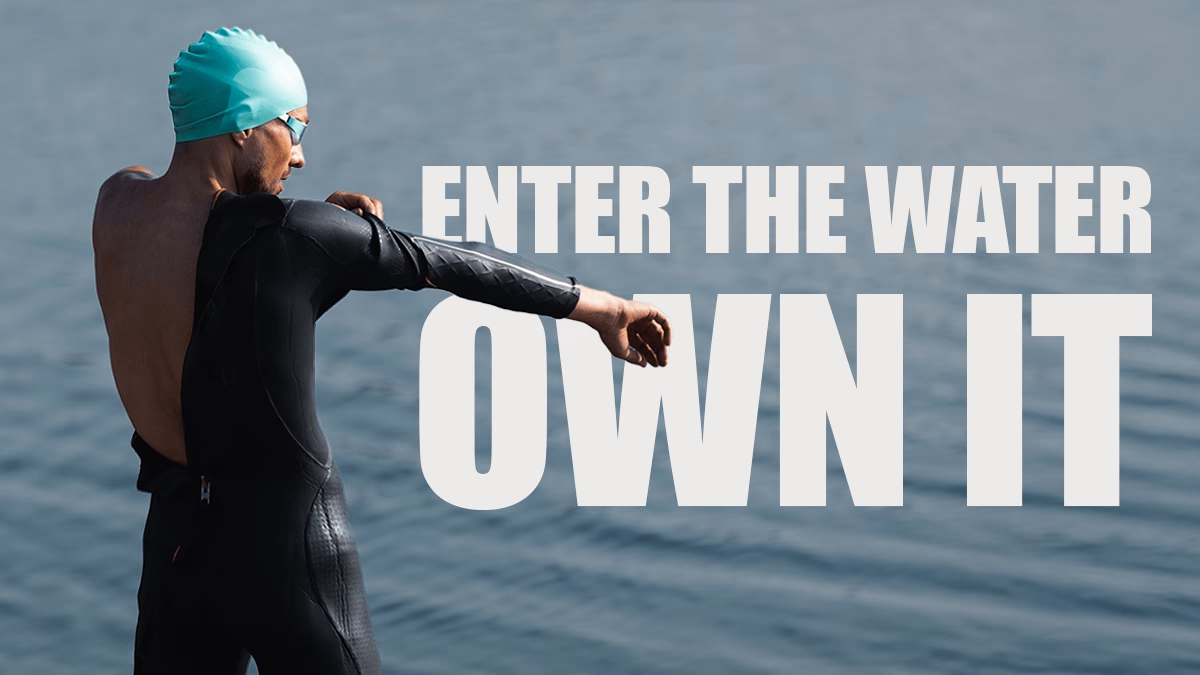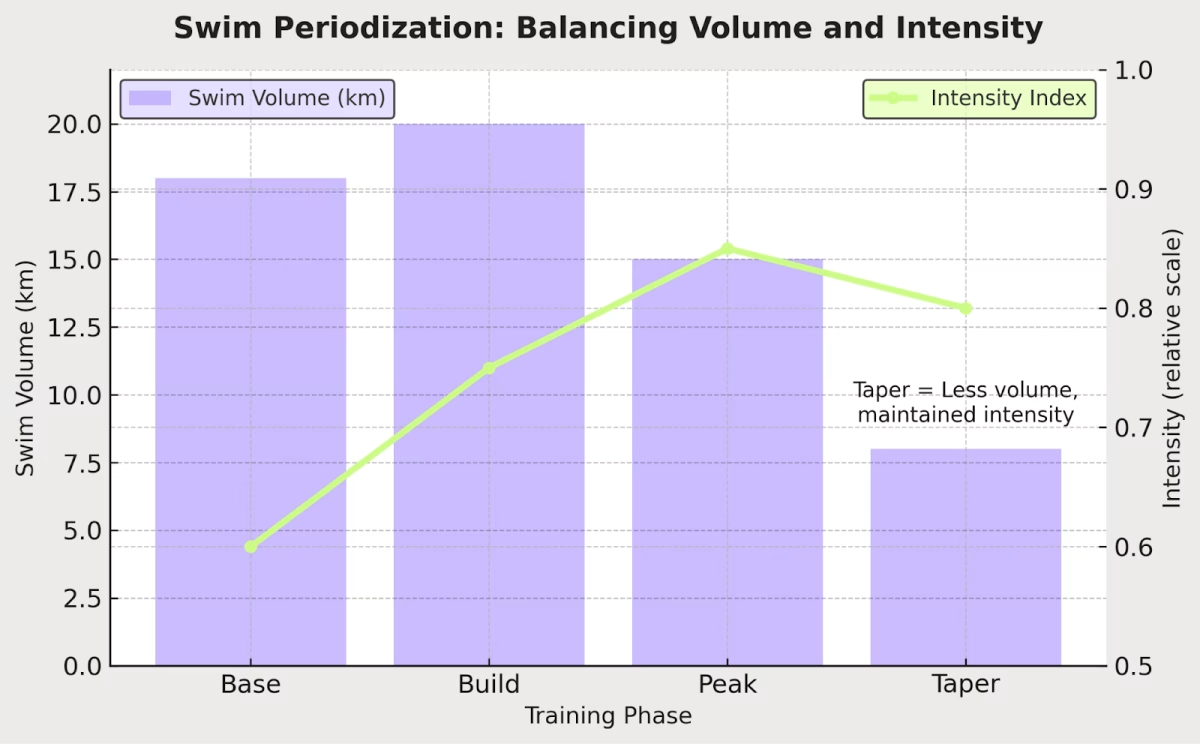Triathlon Swim Training: Building Endurance and Efficiency the Smart Way

The Smart Approach to Swim Training
For many triathletes, the swim is more than the first leg of a race — it’s a psychological hurdle. The open water, the chaotic start, and the technical precision it demands make it unlike cycling or running. You can’t “muscle through” poor form in the water. Every inefficiency costs energy — and time.
But swimming fitness is only part of the equation.
True progress comes from combining technique, endurance development, and data-driven structure.
Today’s best triathlon coaches aren’t prescribing laps — they’re designing swim sessions that develop aerobic power, refine mechanics, and sync with the athlete’s overall training load. With the right tools, it’s possible to train smarter — not just longer — and reach the start line ready to perform efficiently and confidently.
The Foundation: Understanding Endurance in Swimming
Endurance in swimming works differently than on land. Water imposes resistance nearly 800 times greater than air, and that changes the game.
A well-trained runner can rely on stride rhythm and oxygen delivery. But swimmers must manage buoyancy, drag, and breathing coordination — often under high muscular tension. This means technical economy becomes just as important as cardiovascular conditioning.
Scientific research shows that:
- Competitive swimmers exhibit a strong link between stroke efficiency and energy cost, even more than aerobic capacity (Toussaint & Hollander, 1994).
- Improving swimming economy — how efficiently an athlete moves through the water — can reduce oxygen demand by up to 10–15% at a given pace (Pendergast et al., 2006).
Coaching takeaway:
During base training, focus on skill-driven aerobic sets rather than pure volume. The goal is to make each stroke more efficient — not just cover more distance.
Example:
Instead of 10 × 200m at moderate effort, try 8 × 200m, focusing on consistent stroke count per length and smooth turns.
Structuring Training Zones: From CSS to Intensity Distribution
Triathletes love data — and swimming finally has a metric that rivals running pace or cycling power: Critical Swim Speed (CSS).
CSS represents the pace an athlete can sustain for around 30 minutes without fatigue overwhelming technique. It’s usually determined by timing 200m and 400m time trials:
CSS = (Time for 400m – Time for 200m) ÷ 2
From there, you can define practical training zones:
- Z1 (Recovery / Technique): < 90% CSS
- Z2 (Aerobic Endurance): 90–95% CSS
- Z3 (Threshold): 95–102% CSS
- Z4 (VO₂ / Race-Specific): 103–110% CSS
Why it matters:
Training by CSS allows you to align swimming effort with your running and cycling zones, creating a unified endurance framework.
Research highlight:
A 2021 study by Pla et al. (Frontiers in Physiology) found that both polarized (80/20) and pyramidal intensity distributions improved aerobic markers and time trial performance in triathletes — but polarized training produced slightly better fatigue resistance.
Coaching takeaway:
Base ~80% of swim training around aerobic or skill work (Z1–Z2) and 20% on controlled threshold/VO₂ sets. Avoid “gray-zone” training that’s too hard for recovery, but not hard enough for adaptation.
Example session:
12 × 100m at CSS pace, 20s rest — maintain even pacing and stroke count.
Technique and Efficiency: The Hidden Endurance Multiplier
Technique isn’t just about looking smooth — it directly determines endurance.
Every excess movement increases drag, and every inefficient pull wastes energy.
Key efficiency factors:
- Stroke Length (SL): The distance traveled per stroke.
- Stroke Rate (SR): How many strokes you take per minute.
- Stroke Index: SL × Speed – a practical indicator of economy.
Elite swimmers maintain a balance between stroke length and stroke rate, adjusting rhythm as pace increases without over-spinning their arms.
Research insight:
- Propulsive efficiency can improve up to 20% with optimized stroke mechanics (Pelayo et al., 1996).
- Consistent stroke rhythm under fatigue correlates with better pacing and less performance decline (Seifert & Chollet, 2009).
Coaching takeaway:
Technical work should never stop — even in peak phases. Integrate drills and feedback tools like underwater cameras or stroke counters weekly.
Example session:
“Technique Ladder”:
4 × (25m drill + 50m swim + 25m drill), focusing on catch position, alignment, and relaxed exhale.
Periodizing the Swim: From Base to Race
A successful triathlon swim season follows a clear rhythm — just like cycling or running — through structured periodization:
| Phase | Duration | Key Focus |
| Base (8–12 weeks) | Aerobic capacity, technique | Long aerobic intervals (e.g., 6×400m at Z2) |
| Build (6–8 weeks) | Threshold and VO₂ | CSS intervals, open-water sets |
| Peak (3–4 weeks) | Race-specific intensity | Pace simulation, tempo sets |
| Taper (2 weeks) | Recovery + neural sharpness | 30–40% volume reduction, intensity maintenance |
Evidence:
Tapering with a 40–60% reduction in volume while maintaining intensity enhances power output and swim velocity (Mujika et al., 2010).

Coaching takeaway:
Don’t cram volume late in the season. Focus on sharpness and pacing precision — athletes should arrive fresh, not fatigued.
Measuring Swim Training Load: The Smart Way
Quantifying swim stress is tricky — heart rate data is unreliable underwater, and GPS can be erratic.
But combining pace-based training stress (rTSS) with session RPE offers a robust picture of load.
Practical application:
If a swimmer logs high RPE for a routine aerobic set, it signals poor recovery or excessive cumulative fatigue — prompting a coach to adjust training.
Coaching takeaway:
Smart data helps athletes connect effort with adaptation. The best swim sets don’t just hit pace — they fit into the bigger performance picture.
Key Takeaways
- Build endurance through aerobic base and technical control.
- Use CSS to anchor training zones and monitor improvement.
- Maintain ~80/20 intensity balance for sustainable progress.
- Prioritize technique refinement throughout the year.
- Quantify training load for smarter recovery and better race readiness.
Conclusion – Swim Smarter, Race Stronger
Triathlon swim training is no longer just about surviving the first leg.
It’s about mastering the relationship between technique, physiology, and strategy.
By combining structured endurance work, data-driven analysis, and deliberate recovery, triathletes can transform swimming from their weakest link into a competitive advantage.
Because in triathlon, the smartest athletes aren’t just the fastest — they’re the most efficient.
References
- Pla, R. et al. (2021). Polarized vs. Pyramidal Training Intensity Distribution in Triathletes. Frontiers in Physiology.
- Mujika, I. et al. (2010). Tapering and Performance in Endurance Athletes. Sports Medicine.
- Toussaint, H. & Hollander, A. (1994). Energetics of Competitive Swimming: Implications for Training Programs. Sports Medicine.
- Pelayo, P. et al. (1996). Relationship between Stroke Parameters and Swimming Performance. Journal of Sports Sciences.
- Seifert, L. & Chollet, D. (2009). Modelling Coordination in Front Crawl Swimming. Human Movement Science.
- Pendergast, D.R. et al. (2006). Energetics of Swimming. Journal of Applied Physiology.